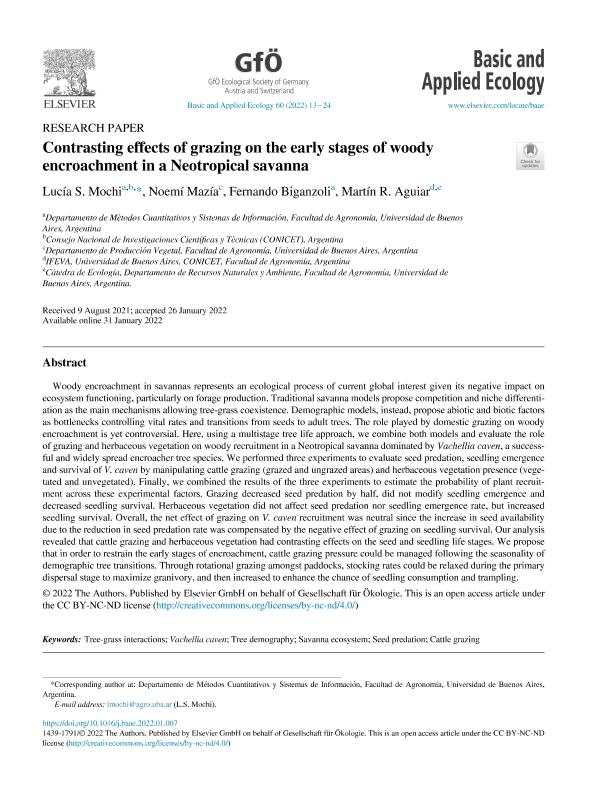Mostrar el registro sencillo del ítem
dc.contributor.author
Mochi, Lucia Sol

dc.contributor.author
Mazía, Cristina Noemí

dc.contributor.author
Biganzoli, Fernando

dc.contributor.author
Aguiar, Martin Roberto

dc.date.available
2023-06-23T16:30:47Z
dc.date.issued
2022-05
dc.identifier.citation
Mochi, Lucia Sol; Mazía, Cristina Noemí; Biganzoli, Fernando; Aguiar, Martin Roberto; Contrasting effects of grazing on the early stages of woody encroachment in a Neotropical savanna; Elsevier Gmbh, Urban & Fischer Verlag; Basic and Applied Ecology; 60; 5-2022; 13-24
dc.identifier.issn
1439-1791
dc.identifier.uri
http://hdl.handle.net/11336/201315
dc.description.abstract
Woody encroachment in savannas represents an ecological process of current global interest given its negative impact on ecosystem functioning, particularly on forage production. Traditional savanna models propose competition and niche differentiation as the main mechanisms allowing tree-grass coexistence. Demographic models, instead, propose abiotic and biotic factors as bottlenecks controlling vital rates and transitions from seeds to adult trees. The role played by domestic grazing on woody encroachment is yet controversial. Here, using a multistage tree life approach, we combine both models and evaluate the role of grazing and herbaceous vegetation on woody recruitment in a Neotropical savanna dominated by Vachellia caven, a successful and widely spread encroacher tree species. We performed three experiments to evaluate seed predation, seedling emergence and survival of V. caven by manipulating cattle grazing (grazed and ungrazed areas) and herbaceous vegetation presence (vegetated and unvegetated). Finally, we combined the results of the three experiments to estimate the probability of plant recruitment across these experimental factors. Grazing decreased seed predation by half, did not modify seedling emergence and decreased seedling survival. Herbaceous vegetation did not affect seed predation nor seedling emergence rate, but increased seedling survival. Overall, the net effect of grazing on V. caven recruitment was neutral since the increase in seed availability due to the reduction in seed predation rate was compensated by the negative effect of grazing on seedling survival. Our analysis revealed that cattle grazing and herbaceous vegetation had contrasting effects on the seed and seedling life stages. We propose that in order to restrain the early stages of encroachment, cattle grazing pressure could be managed following the seasonality of demographic tree transitions. Through rotational grazing amongst paddocks, stocking rates could be relaxed during the primary dispersal stage to maximize granivory, and then increased to enhance the chance of seedling consumption and trampling.
dc.format
application/pdf
dc.language.iso
eng
dc.publisher
Elsevier Gmbh, Urban & Fischer Verlag

dc.rights
info:eu-repo/semantics/openAccess
dc.rights.uri
https://creativecommons.org/licenses/by-nc-nd/2.5/ar/
dc.subject
CATTLE GRAZING
dc.subject
SAVANNA ECOSYSTEM
dc.subject
SEED PREDATION
dc.subject
TREE DEMOGRAPHY
dc.subject
TREE-GRASS INTERACTIONS
dc.subject
VACHELLIA CAVEN
dc.subject.classification
Ecología

dc.subject.classification
Ciencias Biológicas

dc.subject.classification
CIENCIAS NATURALES Y EXACTAS

dc.title
Contrasting effects of grazing on the early stages of woody encroachment in a Neotropical savanna
dc.type
info:eu-repo/semantics/article
dc.type
info:ar-repo/semantics/artículo
dc.type
info:eu-repo/semantics/publishedVersion
dc.date.updated
2023-06-23T14:59:23Z
dc.journal.volume
60
dc.journal.pagination
13-24
dc.journal.pais
Alemania

dc.description.fil
Fil: Mochi, Lucia Sol. Universidad de Buenos Aires. Facultad de Agronomía; Argentina. Consejo Nacional de Investigaciones Científicas y Técnicas. Oficina de Coordinación Administrativa Parque Centenario; Argentina
dc.description.fil
Fil: Mazía, Cristina Noemí. Universidad de Buenos Aires. Facultad de Agronomia. Departamento de Producción Vegetal. Cátedra de Dasonomia; Argentina
dc.description.fil
Fil: Biganzoli, Fernando. Universidad de Buenos Aires. Facultad de Agronomía; Argentina. Consejo Nacional de Investigaciones Científicas y Técnicas. Oficina de Coordinación Administrativa Parque Centenario; Argentina
dc.description.fil
Fil: Aguiar, Martin Roberto. Consejo Nacional de Investigaciones Científicas y Técnicas. Oficina de Coordinación Administrativa Parque Centenario. Instituto de Investigaciones Fisiológicas y Ecológicas Vinculadas a la Agricultura. Universidad de Buenos Aires. Facultad de Agronomía. Instituto de Investigaciones Fisiológicas y Ecológicas Vinculadas a la Agricultura; Argentina
dc.journal.title
Basic and Applied Ecology

dc.relation.alternativeid
info:eu-repo/semantics/altIdentifier/url/https://linkinghub.elsevier.com/retrieve/pii/S143917912200007X
dc.relation.alternativeid
info:eu-repo/semantics/altIdentifier/doi/http://dx.doi.org/10.1016/j.baae.2022.01.007
Archivos asociados
